
National science academy of Ukraine
National science center "Kharkiv institute of physics and technology"
Institute of high-energy and nuclear physics

National science academy of Ukraine
National science center "Kharkiv institute of physics and technology"
Institute of high-energy and nuclear physics

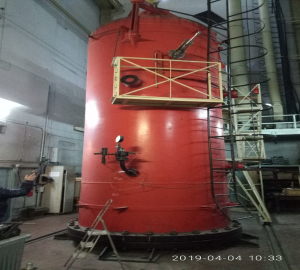

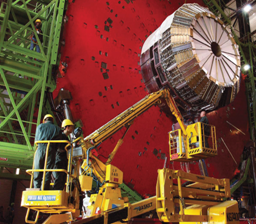

Department of Experimental Investigations on Elementary Particle Physics and High-energy Nuclear Physics
Head of Department - L.G. Levchuk (Ph. D. in Phys.-Math. Sc.)
Tel.: +38(057)3356742
E-mail: ihenp@kipt.kharkov.ua

The history of the Department dates back to the mid-1960s, when the new linear electron accelerator with output energy of 2 GeV (LUE-2000) was under construction at the Kharkov Institute of Physics and Technology (KIPT). The main task of the team created was the development and then fulfillment of a large-scale program of the experimental research on nuclear physics at this facility. Since then for many years, Pavel Vladimirovich Sorokin (see photo below) has been the head of this department of the institute. On his initiative, a number of methodological developments were carried out to study photo- and electronuclear reactions - a beam of polarized photons was obtained and studied, and targets of polarized hydrogen and deuterium nuclei using superconducting magnets along with particle detection systems were developed and constructed. This allowed the institute to have its due place in the worldwide research on nuclear and nucleon structure with electromagnetic probes. In particular, the data on photodisintegration of light nuclei and on pion photoproduction from protons in the delta resonance region (including the then (1970-80s) unique measurements of double polarization observables) accomplished by the Department teams became widely known and well recognized.
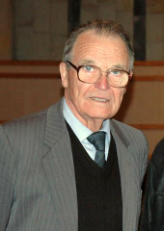
Sorokin Pavel Vladimirovich (1930 - 2017) Dr. of Phys.-Math.Sc, Professor, Honored Scientist of Ukraine Head of the Department (1965 - 2017)
At the same time, the Department carried out a wide range of studies on the interaction of beam electrons with protons and nuclei (including the reactions of nuclear electrodisintegration and pion electroproduction) using magnetic spectrometers, as well as intensive work was performed on studies with chambers of photodisintegration of nuclei into several fragments. A significant part of these measurements was also performed on the KIPT LUE-300 accelerator with the electron beam energy of 300 MeV. After the completion of LUE-2000 operation in the early 1990s, more place in Department scientific activities was given to participation in researches performed within a long- term international cooperation. In particular, a project of the Møller polarimeter for electron beam polarization measurements at Hall A of the Thomas Jefferson National Accelerator Facility (JLab, USA) was developed in the Department. This project was embodied later on, and, since mid-90s, the polarimeter has been successfully operating.
At present, activities of the Department are focused on the following
Main research topics
1. Development of polarized nuclear targets; studies of spin effects in nuclear reactions.
Researchers of the Department take part in nuclear experiments performed in various
laboratories around the world (JLab (VA, USA), JINR and IHEP (Russia), Charles University
(Prague, Czech Republic), Catholic University (Leuven, Belgium), etc.), the purpose of which is
to determine spin observables using targets of polarized nuclei. In particular, targets of polarized
hydrogen and deuterium nuclei (with polarization of 90% and 42%), cryostats of targets and
superconducting magnetic systems have been developed and constructed in the Department.
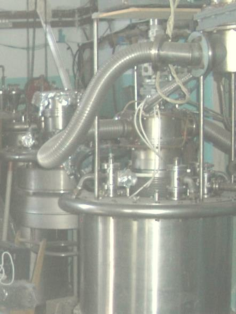 Also, new targets of polarized nuclei (in particular, 3He) are being developed, which can
be used in research carried out at the NSC KIPT. Within the development of the
3Не polarized target
− a multi-channel automated temperature measurement system has been developed
− a magnetic system of Helmholtz coils has been developed and manufactured
− an automated system for the polarization reverse has been developed
Also, new targets of polarized nuclei (in particular, 3He) are being developed, which can
be used in research carried out at the NSC KIPT. Within the development of the
3Не polarized target
− a multi-channel automated temperature measurement system has been developed
− a magnetic system of Helmholtz coils has been developed and manufactured
− an automated system for the polarization reverse has been developed
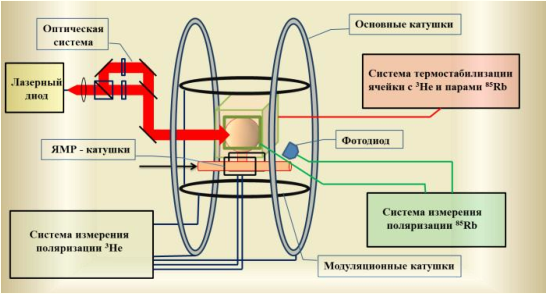
Layout of the polarized 3He nuclear target

Magnetic system of the polarized 3 He target and magnetic field distribution in axial and radial directions of the system
It is planned to use this target as a spin filter to create a beam of polarized neutrons at the NSC KIPT.
2. Participation in the CMS experiment at the Large Hadron Collider (LHC).
Since the early 1990s, activities have started in the Department on the preparation of (and, later on, active participation in) the CMS experiment at the Large Hadron Collider (LHC) at CERN. The team of the Department took part in the development and construction of the endcap hadron calorimeters of the CMS detector.
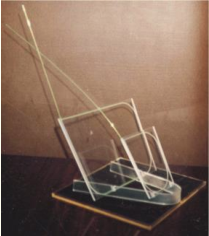
SCSN-81 (Kuraray, Japan) scintillator tiles which make up active elements of the CMS detector endcap calorimeters; a Department team carried out quality control for such tiles (in total, 22 thousand items) during their mass production at ISMA NASU.
After the LHC start-up in the end of 2009, the Department takes an active part in processing of data accumulated in this experiment. For this purpose, a Department team created a computing facility, which has gradually developed into a Tier-2 center of the computing Grid infrastructure for the CMS data processing (the only such center in Ukraine, and one of ∼ 50 similar ones over the world). The CMS data flow to the facility (referred to in the CMS as T2_UA_KIPT) for processing is almost continuous. Since the beginning of collider operation, more than 10 Petabytes of experimental information obtained in the CMS experiment has been transferred to the T2_UA_KIPT site for processing (as of mid-2019). The department also carries out work on the physics analysis of the CMS data (aimed, in particular, at search for SUSY particles), as well as participates in R & D activities on upgrades of the CMS detector hadron calorimetry.
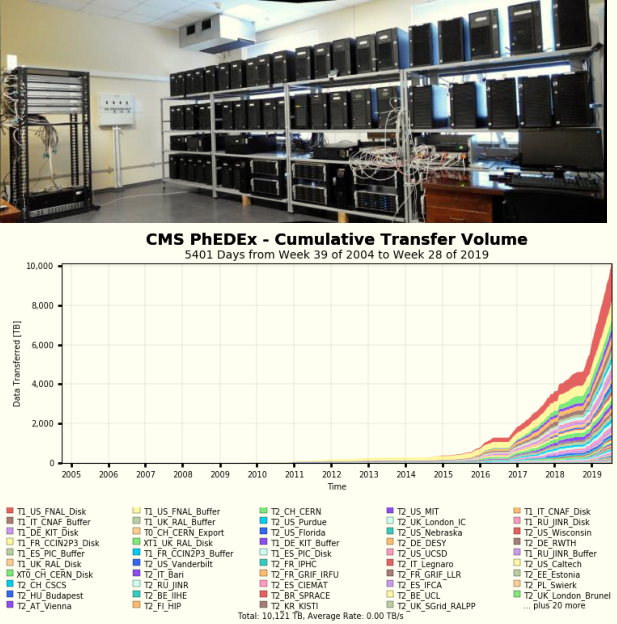
NSC KIPT computing facility allocated for processing of data from the Large Hadron Collider (Tier-2 center of the CMS Grid infrastructure referred to as T2_UA_KIPT, photo taken in 2015), and chronology of CMS data transfers to the facility for processing (as of mid- 2019) from other CMS centers specified on the diagram (information taken from cmsweb.cern.ch/phedex )
In 2012, the Higgs boson was discovered in the CMS and ATLAS experiments, and the CMS participants from the Department are co-authors of this outstanding discovery, as well as of more than 900 publications (as of mid-2019) of the CMS collaboration with measurements on the LHC.
3. Experimental studies of multi-particle photo-disintegration of light nuclei with the chamber techniques
Based on the analysis of data obtained using the streamer and diffusion chambers in a magnetic field under the beam of bremsstrahlung photons with energies up to 150 MeV, important results on the multiparticle photodisintegration of light nuclei have been obtained for the last years. In particular, momentum distributions for the γ+ 4He→p+n+d reaction products have been measured, along with the energy and angular correlations for 4 photon energy ranges. The analysis of the angular and energy correlations has been carried out. The results obtained were interpreted within triangle and pole mechanisms for the quasi-deuteron model of photon absorption, and the relative contribution of these mechanisms has been determined. The 12C(γ,3α), 16O(γ,4α) і 16O(γ,n) 3He3α reactions were also studied. The 16O(γ,αα) 8Ве and 16O(γ,n) 3He α 8Ве partial channels have been identified, and production of the 12С nucleus in the near-threshold α-particle states was observed. A number of methodological developments were performed to enable further work on the experimental studies of multiparticle photodisintegration reactions with the diffusion camera in a magnetic field: a digital bank of film frames taken from the diffusion camera was created, and ways to implement the automatic extraction of the track coordinates in event photos were studied.
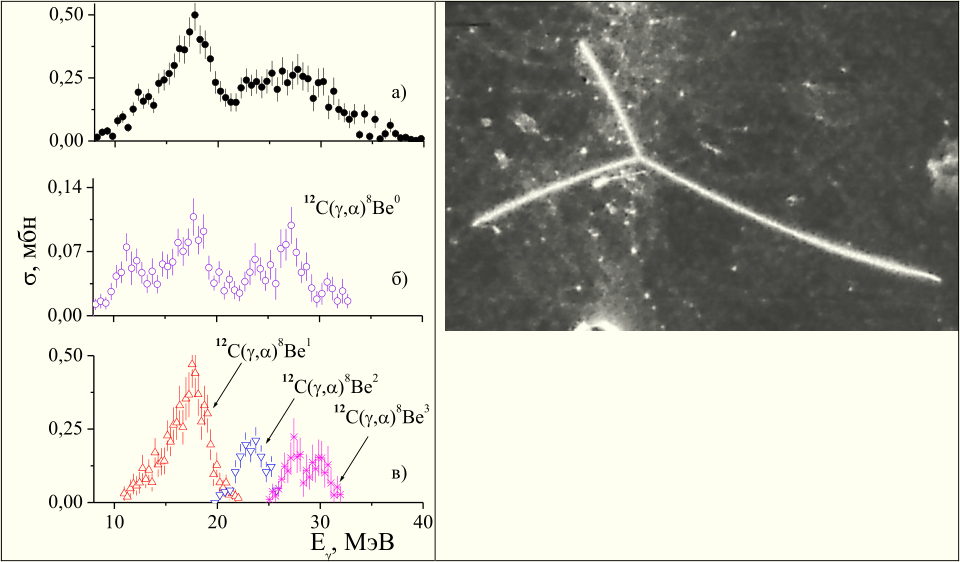
Results of measurements: total cross section of 12С(γ, 3α) reaction (on the top) and contributions of partial channels with formation of an intermediate-state 8 Ве nucleus ( 12 С(γ, α)8Ве reaction) in the ground state (in the middle) and with excitation of 1-st, 2-nd and unseparated 3-rd and 4-th levels (on the bottom); on the right is a snapshot of this reaction from the diffusion chamber
International Cooperation
1. European Organization for Nuclear Research [CERN] Direction of collaboration – participation in the CMS experiment at the Large Hadron Collider: support and development of the Tier-2 center (T2_UA_KIPT) of the CMS computing grid infrastructure for data processing; physics analysis of the data aimed at search for signals of the "new physics" work on modernization of the CMS hadron calorimetry
2. Thomas Jefferson National Accelerator Facility [TJNAF, Jefferson Lab, JLab] (USA), Joint Institute for Nuclear Research [JINR], Institute for High Energy Physics [IHEP] (Russia), Charles University (Prague, Czech Republic), Catholic University of Leuven (Leuven, Belgium) Direction of collaboration – participation in experiments on determination of polarization observables using targets of polarized nuclei
3. Image Access Inc., Digital Library Systems Group, Roca Raton, FL, USA Direction of collaboration – software testing within the «Research collaboration agreement between National Science Center "Kharkiv Institute of Physics and Technology", Kharkiv, Ukraine and Image Access Inc., Digital Library Systems Group, Roca Raton, FL, USA»
Selected Recent Publications
1. D.Flay et al. (Jefferson Lab Hall A Collaboration), "Measurements of dn2 and An1: Probing the neutron spin structure" // Physical Review. - 2016. – V D94: 052003.- № 5. - P. 1-51.
2. D.S.Parnoa et al. (Jefferson Lab Hall A Collaboration), "Precision measurements of An1 in the deep inelastic regime" // Physics Letters. – 2015.- V. B744. - P. 309–314.
3. W.R.Armstrong, S.Choi, E.Kaczanowicz, A.Lukhanin, Z.-E.Meziani, B.Sawatzky, "A threshold gas Cherenkov detector for the Spin Asymmetries of the Nucleon Experiment" // Nuclear Instruments. and Methods A - 2015. - V 804.- P. 118–126.
4. V.V.Abramov et al., "Analyzing Power in the Reaction p + p→π0+ X in the polarized- target fragmentation region at an energy of 50 GeV" // Physics of Atomic Nuclei. - 2014. -V 77. –N. 5. - P. 595–601.
5. Ye.S.Gorbenko, R.T.Murtazin and A.F.Khodiachikh, "Investigation of the reaction 4Нe(γ,pn)d at energies below the meson-production threshold" // Physics of Atomic Nuclei. - 2017. -V 80. – № 1. - P. 26–32.
More than 900 publications within the CMS Collaboration, in particular
6. S.Chatrchyan et al (CMS Collaboration), "Observation of a new boson at a mass of 125 GeV with the CMS experiment at the LHC" // Physics Letters. – 2012.- V. B716. №1.- P. 30–61.
7. G.Aad et al. (CMS and ATLAS Collaborations), "Combined Measurement of the Higgs Boson Mass in pp Collisions at s =7 and 8 TeV with the ATLAS and CMS Experiments" // Physical Review Letters. – 2015. – V. 114: 191803. – №19. – P. 1-33.
8. G.Aad et al. (CMS and ATLAS Collaborations), "Measurements of the Higgs boson production and decay rates and constraints on its couplings from a combined ATLAS and CMS analysis of the LHC pp collision data at √s = 7 and 8 TeV" // Journal of High-Energy Physics. – 2016. – V. 2016: 045. – №08. – P. 0-112.
9. V.Khachatryan et al (CMS Collaboration), "Precise determination of the mass of the Higgs boson and tests of compatibility of its couplings with the standard model predictions using proton collisions at 7 and 8 TeV" // European Physical Journal C. – 2015. – V. C75: 212. – №5. – P. 1-50.
10. S.Chatrchyan et al (CMS Collaboration), "Measurement of the properties of a Higgs boson in the four-lepton final state" // Physical Review. – 2014. – V. D89: 092007. – № 9. – P. 1-45.